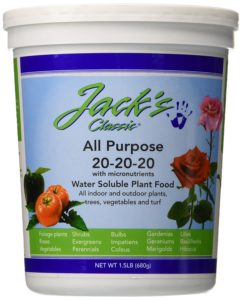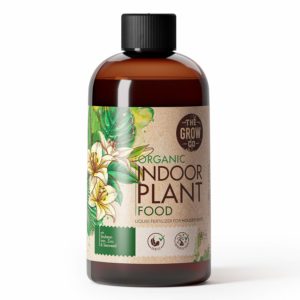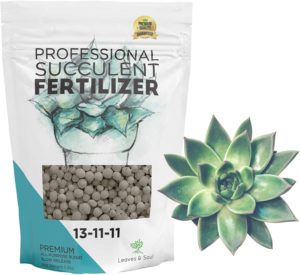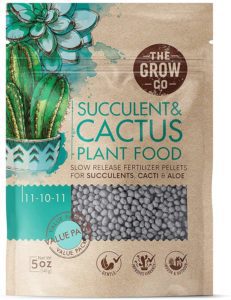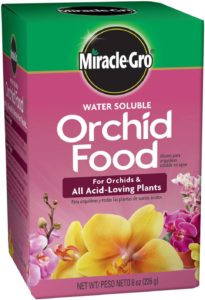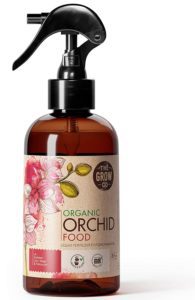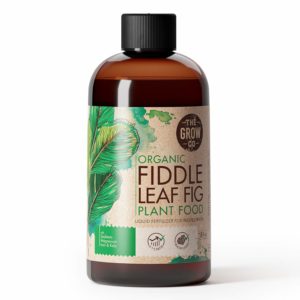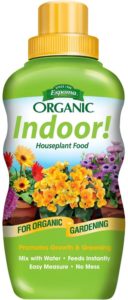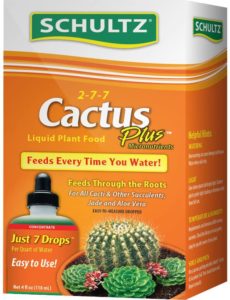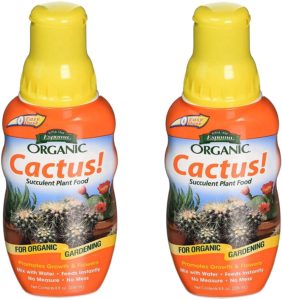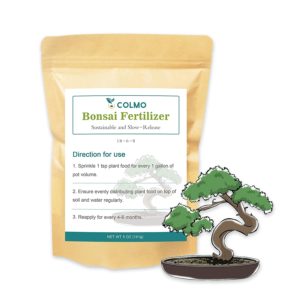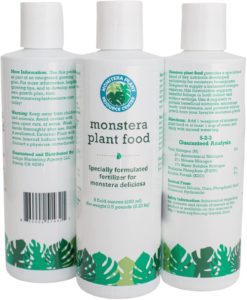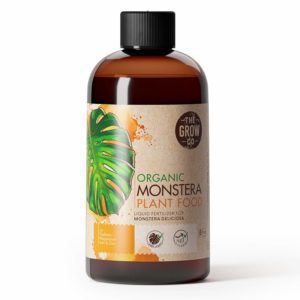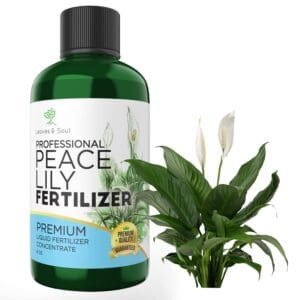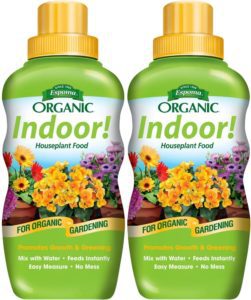Just like in an outdoor setting, healthy nutrient-rich potting soils produce strong, healthy indoor plants. But instead of the rain, the decay of leaf matter, and fallen trees that replenish a forest’s soils, you are the life giver and the bearer of nutrients.
Let’s get you up to speed with all things fertilizer ratio. That way, you can fertilize your hungry houseplants with the indoor plant fertilizer nutrient blend that they most prefer.
What is the role of fertilizer in plant health?
A plant fertilizer is any type of naturally occurring matter or a mix of chemical substances that is mixed with a growing medium to improve the growth of plants.
Plant fertilizer manufacturers make fertilizers that contain mostly nitrogen, phosphorus, potassium, coupled with various other essential secondary nutrients and micronutrients – all essential ingredients for a healthy plant. Next to regular watering, applying fertilizer to your plants fights the causes of yellow leaves, withering and stunted growth.
What are the different types of plant fertilizers?
Inorganic fertilizer
Inorganic fertilizers, sometimes referred to as chemical fertilizers or synthetic fertilizers, are those derived or synthesized from non-living materials. These are typically nutrients that are mined from ores, rocks, or are synthetically produced in a lab.
The most common inorganic fertilizers include synthetic fertilizer products like ammonium nitrate, calcium nitrate, phosphorus, potassium chloride, superphosphate, and urea.
Organic fertilizer
Manufacturers make organic fertilizers from organic matter such as manure and decomposing vegetation. Organic fertilizers are often used to replace synthetic chemical fertilizers in gardens and farms, which helps reduce the environmental effects of agricultural practices. Organic fertilizers gradually release nutrients into the soil, reducing the frequency at which they need to be applied.
Often organic fertilizers also contain beneficial microbes like soil borne bacteria and mycorrhizal fungi. These microscopic organisms are great for both plant and soil health.
What are the different forms of plant fertilizer?
There are several types of fertilizer out there, each with suited to specific seasons and types of plants. When dosing fertilizer, it’s helpful to understand how much fertilizer plants generally like, and then always to double check the label of your particular fertilizer before applying. Here are a few types of fertilizer to know:
Liquid or water-soluble fertilizer
Liquid fertilizers are solutions that contain plant nutrients in liquid form. They come in concentrated form to save shipping weight, reduce contamination risks, and improve storage life. This means, when you use a liquid fertilizer, you’ll have to dilute it down to a suitable water:fertilizer ratio.
If you were to apply a liquid fertilizer straight out of the packaging, you’d most likely over-fertilize your plants and cause them harm. This is often a common occurrence with the application of too much synthetic fertilizer.
Conversely, as long as the product instructions followed, that’s one advantage of liquid fertilizers. As it is water soluble, plants absorb it quickly, delivering fast results.
Perfect for plants that desperately need a good dose of essential nutrients.
Controlled or slow-release fertilizer
Slow-release fertilizers deliver nutrients at a slower, more controlled rate. This allows plants to make use of the nutrients over a longer period of time. The most common forms of these products are granular but slow-release fertilizers also come in pods, capsules, or even spikes that can be driven down into a potting soil.
Slow-release fertilizers are popular amongst many gardeners as they release nutrients over time, reducing the need for frequent reapplication, and dramatically lowering the risk that over-fertilization will occur.
Dry fertilizer
Although more commonly used for outdoor applications, dry fertilizer is a type of soil amendment that is composed of rock powders, minerals, and dried animal manure. When applied to a potting mix, the dry fertilizer quickly absorbs moisture from the soil and subsequently releases nutrients that are then absorbed by a plant’s roots.
The most common type is ammonium sulfate, which provides ammonium ions through its sulfate acid group. Other types that you may have heard of include phosphate rock, borax, gypsum, and lime.
What is the nitrogen-phosphorous-potassium ratio (NPK meaning)?
When hunting down a fertilizer that is suitable for indoor plants, you’ll often come across products that mention an NPK ratio on their fertilizer label.
NPK is an abbreviated term for the essential macronutrients: nitrogen, phosphorus, and potassium. When referred to in a horticultural context, NPK is a ratio of the three nutrients necessary for plant growth.
The NPK ratio affects the quality and quantity of a plant’s root structure, vegetative organs, and its ability to withstand disease, pathogens, and pests.
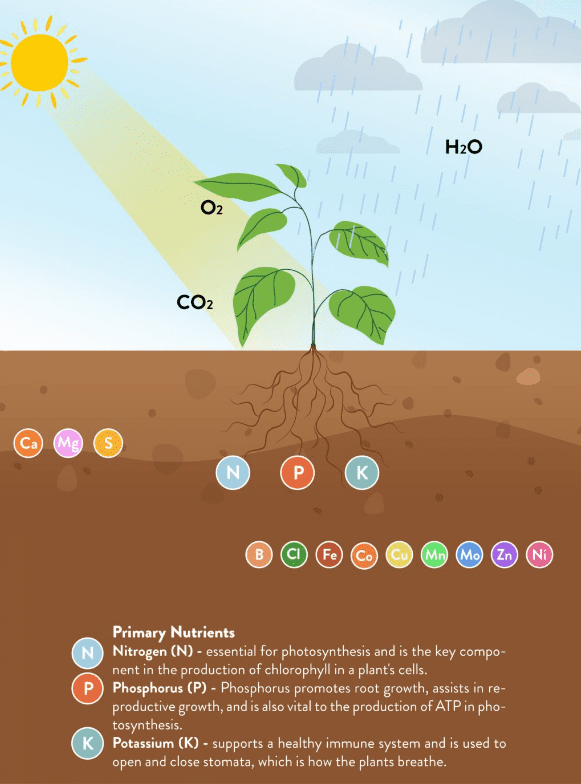
These three nutrients are integral to the health of plants. Each play their own vital role.
Nitrogen (N)
Nitrogen is a crucial nutrient for plant health, especially important in the development of chlorophyll and other molecules that allow plants to synthesize glucose to fuel healthy growth.
It is also a key component of a plant’s cell walls, DNA, and other plant proteins. You’ll spot nitrogen deficiencies by stunted growth rates and chlorosis (yellowing of the leaves).
Phosphorus (P)
Phosphorus encourages both root growth and blooming. It is also an essential to plant health as it plays a key role in photosynthesis and water transport. Particularly important for flowering plants, it aids the growth of enzymes used in the development of seeds and other reproductive structures like flowers.
Phosphorus also converts into sugar during photosynthesis. And plays a key role in the process of nitrogen fixation. Phosphorus deficiencies often lead to the reduction of shoot growth, while also turning a plant’s leaves dark, blue-green, or reddish.
Potassium (K)
Potassium is an essential macronutrient for plants. It functions to maintain plant health, aiding in photosynthesis, regulating stomatal openings (used for gas exchange), and promoting water uptake. Potassium is also an essential element in the development of healthy flowers and fruit.
And aids in a plant’s ability to resist pests and diseases. Plants with a potassium deficiency may show symptoms such as yellowing leaves, stunted growth and wilting.
NPK fertilizer numbers explained
A good rule of thumb when choosing the right fertilizers for your houseplants is to look at the NPK ratios on the label. If it says “30-10-20”, then this means the fertilizer contains 30% nitrogen (N), 10% phosphorus (P) and 20% potassium (K). Or with this same ratio, a 1L bottle of liquid fertilizer would contain 300ml of nitrogen, 100ml of phosphorus, and 200ml of potassium.
The rest?
Well, that is mostly fillers. Think of it like a vitamin pill – let’s say a B12 tablet.
Sure, a sublingual B12 tablet contains the vitamin B12, but it may also contain fillers like cellulose, gelatin, or artificial colors and flavors that make it more appealing to the consumer.
Fertilizers are the same. Although in this case, fillers are used to make the plant fertilizer easier to spread or administer.
Perhaps more important than fillers, fertilizers also contain the many secondary and micronutrients (sometimes referred to as trace minerals or elements) that are also essential to growing healthy plants.
This includes the secondary elements
- calcium (Ca),
- magnesium (Mg),
- and sulfur (S).
And the micronutrients
- boron (B),
- chlorine (Cl),
- cobalt (Co),
- copper (Cu),
- manganese (Mn),
- iron (Fe),
- molybdenum (Mo),
- Zinc (Zn),
- and nickel (Ni).
To see a detailed guide on all the essential nutrients an indoor plant requires, check out our full breakdown of plant nutrients here.
What is the ideal NPK ratio?
For the best NPK ratio, there isn’t a one size fits all approach.
Why?
Well sure, all plants need macronutrients, secondary nutrients, and micronutrients to survive. But they need them in varying levels depending on their life cycle, growth, and reproductive habits.
For example, plants that are grown in dense soils are heavier feeders of nitrogen and phosphorus. These plants use nitrogen and phosphorus for vigorous root growth, ideal for reaching the moisture and nutrients locked within the soil.
Some plants are heavy feeders of potassium, which is used in photosynthesis and subsequent growth. While other plants love a balanced combination of NPK and the various trace elements – like zinc, boron, and molybdenum – that they need to produce adequate flowering and bountiful fruit set.
Regular fertilization also has the added benefit of supporting soil life. The biomass of beneficial soil microbes actually increases with fertilizer applications, research showing a boost of up to 15%. This means your plants aren’t just receiving an influx of primary and other nutrients when you fertilize, but the soil that supports them is also receiving a boost in its health too.
So what about your indoor plants? Well, different plants require different nutrition.
Let’s look at different fertilizer ratio use cases.

Share this Image On Your Site
For general balanced nutrition
If you don’t want the headache of choosing a different fertilizer for every different type of indoor plant you keep, why not find a fertilizer that has a balanced NPK ratio coupled with adequate amounts of secondary and micronutrients. Something like a
- 1-1-1 fertilizer,
- 2-2-2 fertilizer,
- 5-5-5 fertilizer,
- or 10-10-10 fertilizer
will do the job.
If you want to tailor your fertilizer regime to different indoor plants and meet their exact requirements, you could purchase specialized fertilizers that suit their individual needs.
Succulent fertilizer ratio
Succulents can thrive in a wide variety of soil compositions and conditions, but they may only need a light application of fertilizer. A one time application in late summer will suffice for most varieties with a
- 1-1-1
- 5-10-10 fertilizer,
- 13-11-11 fertilizer,
- 15-15-15 fertilizer,
- or 14-14-14 fertilizer.
Orchid fertilizer ratio
For optimal results with orchids, it’s best to fertilize once a week or at least once a month. Orchids mostly enjoy a subtle fertilizer blend, something like a
- 3-1-2 fertilizer,
- 3-1-3 fertilizer,
- 30-10-10 fertilizer,
- or a balanced fertilizer like a 1-1-1 blend.
Fiddle leaf fig fertilizer ratio
The Fiddle Leaf Fig is a plant that requires a delicate balance of nutrients if it is to thrive. If the plant is not given enough fertilizer, the leaves will lose their beautiful dark green color.
Something like a
- 3-1-2 fertilizer,
- 6-2-4 fertilizer,
- or balanced 10-10-10 fertilizer
will do just fine.
Snake plant fertilizer ratio
Snake plants are slow growers and should only be fertilized about twice a year. A good rule of thumb would be to fertilize them in the spring for rejuvenation and then again in the fall.
A well-balanced
- 2-2-2 fertilizer,
- 10-10-10 fertilizer,
- or 20-20-20 fertilizer
will do the job just fine.
Cactus fertilizer ratio
Cacti should be fertilized just once or twice a year to ensure that they are getting all the nutrients they need to grow and maintain optimal health. The end of winter and the first part of spring are a good time to fertilize. This is simply because cacti can be more susceptible to nutrient deficiencies during these periods.
A blend of
- 1-2-2 fertilizer,
- 2-7-7 fertilizer,
- 5-10-10 fertilizer,
- 5-15-10 fertilizer,
- or 10-10-10 fertilizer
is suitable.
Money tree fertilizer ratio
In order to maintain a healthy Money Tree, it is essential that the plant be fertilized as often as once per month. This ensures that it will have a steady stream of nutrients, which aids in the growth and development of strong leaves.
A blend like a
- 10-10-10 fertilizer,
- 18-6-11 fertilizer,
- or 20-20-20 fertilizer
are both great options.
Monstera fertilizer ratio
The frequency of fertilization will vary depending on each individual Monstera plant. Factors like its age, size, and growing conditions will all play an effect. Monthly fertilization with standard soil-based commercial houseplant fertilizer is sufficient, just be sure to follow the guidance of fertilizer labels.
Monsteras enjoy a blend of
- 3-2-1 fertilizer,
- 2-1-1 fertilizer,
- 5-2-3 fertilizer,
- or a 20-20-20 fertilizer.
Peace lily fertilizer ratio
Peace Lilies aren’t particularly fussy and only require feeding 2-3 times during the growing season. This will give them access to plenty of primary nutrients and secondary nutrients to help grow robust growth and beautiful white flowers.
Peace lilies enjoy a blend of
- 2-1-2 fertilizer,
- 2-2-2 fertilizer,
- Or 10-10-10 fertilizer.
Final thoughts
Indoor plants should be fertilized regularly to keep them happy and healthy. Particularly important to container plants, regular fertilization can improve a plant’s appearance and longevity while promoting healthy flowering and fruit set.
If you’re worried about under or over fertilization, like adding too much nitrogen, a great way to get your fertilizer regime dialed in is to use a soil test.
In just a few minutes, a quick soil test will shed light on exactly where your plant soil’s nitrogen, phosphorus, and potassium levels sit. Using your soil test results, you can easily make any required amendments without the risk of harming your houseplants.
More about fertilizing
- 10 Best Worm Composter Bins For Easy Homemade Compost
- Compost Starter 101: When You Need It And How To Make It
- Our top pothos fertilizer picks for luscious vines
- 5 reasons to use coffee as fertilizer for your plants
- Best fertilizer for Monstera plants for gorgeous leaves
- Fertilizer Burn on Plants? Here’s How to Fix it
- Fiddle leaf fig fertilizer: How to feed your fiddle leaf


